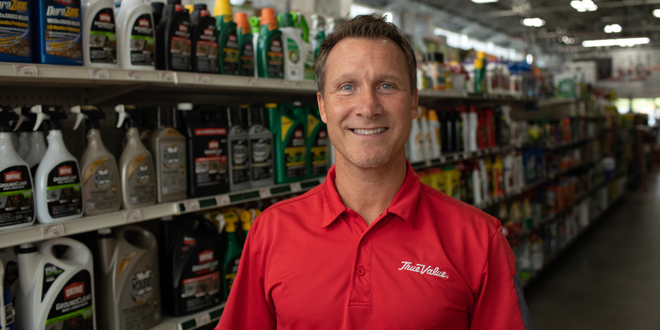Even before COVID-19 disrupted retail, customers were increasingly shifting to e-commerce solutions and exploring how contactless commerce could add convenience and value to their lives. Now a year and a half after the pandemic first altered retail operations across verticals, contactless commerce is becoming an important pillar of home improvement retailers’ businesses.
According to Forbes, contactless payments have grown by 150 percent since March 2019, rising as the pandemic motivated many shoppers to seek safe shopping alternatives. Nearly 85 percent of home improvement retailers surveyed by the North American Hardware and Paint Association say they implemented curbside pickup, a key component of contactless commerce, at their businesses in the past year.
Chad Ayers, owner of Allendale True Value, was one of those retailers. He knew shifting his operation’s status quo in light of the pandemic was not only profitable, but necessary to survive. Discover how he introduced contactless commerce to his operation and refined it with e-commerce solutions.
Plus, hear from Garrett Schwegler, program manager for software company Lucidworks, on how retailers can stay connected with customers, even as contactless commerce becomes more prominent across retail sectors.
Even if your operation isn’t on the forefront of technology, understanding the principles of contactless commerce and how they can differentiate your business from competitors is key to modern retail.
E-Commerce Innovation
Ayers says one of his favorite aspects of being an independent home improvement retailer is the ability to grow and mentor his team. He oversees roughly 50 employees at his business, and like other retailers during COVID-19, he learned to adapt to meet the needs of his team and his customers seamlessly.
“COVID-19 has been tough on everyone,” he says. “We got through 2020, and at the start of this year, we told the team that it took every ounce of every person’s effort to get here. I like to say that if we could get through COVID-19, we can get through anything.”
In addition to his team’s flexibility and ingenuity, Ayers says one of the key ways his operation persevered through the pandemic was through embracing contactless commerce, particularly with timely investments in e-commerce.
Like other retailers, Ayers knew e-commerce would be an important component for his business, and he started exploring its possibilities roughly five years ago. But he says those initial forays were clunky, time-consuming and ultimately didn’t fit his vision for e-commerce integration. As COVID-19’s enormous impact on retail operations grew clear, Ayers knew it was time to revisit e-commerce, refine it for his business and reintegrate it into the operation’s overall contactless commerce offering.
Making the Jump
As COVID-19 began spreading throughout the U.S., Ayers and his team quickly pivoted to meet new demands from customers, establishing a curbside order fulfillment process and instituting buy online, pickup in store (BOPIS) options. The company had a new e-commerce platform offered through its wholesaler, True Value, in the early days of the pandemic, and while Ayers says it met the need, he and his team still wished to refine the service.
The initial e-commerce platform fulfilled early needs, but only featured True Value products, which Ayers says account for roughly 60 percent of his overall inventory. Compounding matters was a lag in inventory updates. Available inventory was only updated once a day, meaning customers could log on and erroneously see a product was in stock, when in fact it was depleted.
“That was especially hard for popular items early in the pandemic, like masks, gloves and cleaning products,” Ayers says.
The remainder of 2020 reinforced to Ayers and his team that e-commerce would need to be a reliable pillar of their business moving forward. He and his team again worked with True Value and launched an updated e-commerce platform earlier this year, featuring not only the suite of True Value products he carries, but also special-order items from True Value’s warehouses and products from other suppliers.
“The new platform is a complete game-changer,” Ayers says. “We have full control over how we set up the website: product placement, headers, the home page and multiple custom pages.”
He says the software behind the e-commerce solution, which is exclusive to True Value retailers, is intuitive, allowing nearly everyone on his staff the opportunity to edit it. But Ayers sees the long-term potential of e-commerce as a new arena for his business. Earlier this summer, he promoted someone into a new role for his business: e-commerce sales manager.
That role will oversee e-commerce sales not only on the company’s website, but also on other online marketplaces, including eBay and Facebook.
“We want to see if we can compete in this space in the big picture, so it warrants investing in someone to help us get it off the ground,” Ayers says.
A Timely Decision
A pivot to refining e-commerce was resoundingly timely. Ayers says one of the clearest lessons he’s learned since the pandemic began was that product availability trumps every other factor in customers’ purchase decisions. For example, one of the company’s online bestsellers is Adirondack chairs, a product Ayers and his team stocked up on in the early days of the pandemic and have promoted online. That move added visibility to the company’s sales platform, garnering new sales to customers far and wide.
“E-commerce is giving us eyeballs on inventory,” Ayers says. “From 2018 to 2019, our total transaction counts were within seven transactions of one another. In 2020, we were up 12,000 transactions. E-commerce has been a major difference.”
Even as transaction rates have stabilized throughout 2021, Ayers says e-commerce is still pulling its weight; sales are above 2020 levels, even with lower transaction counts than in 2020, indicating those online shopping carts are higher than ever, bringing sales—and new opportunity—to Allendale True Value.
Ayers says one of the main challenges of managing a robust e-commerce offering is ensuring inventory is accurate. Lagged updates online can cause on-the-ground frustrations for customers and staff alike.
“Because it’s live, it can be scary,” he says. “Your inventory has to be accurate; when it’s off, it creates a lot of inefficiencies. Customers are looking for items you don’t have and that leads to frustrations.”
Before launching the newest version of his e-commerce platform, Ayers and his team committed to doing a physical inventory of the entire store, helping solidify inventory levels before wading into the digital frontier.
What the Future Holds
E-commerce success is also affording Allendale True Value brick-and-mortar opportunities. Ayers and his team recently completed a 10,000-square foot expansion of the business, allowing the operation to grow into new categories and invest even deeper in existing offerings.
The new expansion will predominantly feature appliances, helping the business grow sales in a lucrative category.
Ayers says e-commerce wins have also encouraged his team to search for new ways technology can strengthen the business. Now, employees are equipped with two monitors at point of sale locations, helping them run transactions on one screen while searching inventory and finding other pertinent information for customers on the other.
“I’m very supportive of tech,” Ayers says. “I’m also interested in creating efficiencies. Anywhere I can grow efficiencies for the team, I jump at those opportunities.”
Technology Creates New Connections
In his role as program manager for Lucidworks, which offers a suite of e-commerce solutions for retailers, Garrett Schwegler sees firsthand how technology can enhance connections to customers, even if transactions grow increasingly contactless. Get three insights into how technology can help you grow closer to customers, even if transactions are contactless.
 1. You don’t have to be a data scientist to use technology.
1. You don’t have to be a data scientist to use technology.
“Many of our customers wondered how they could access AI methods that don’t require them to be highly specialized,” Schwegler says. “They don’t have data scientists on staff or deep pockets to invest in something extreme, but tech providers offered different solutions that democratized artificial intelligence and got it in the hands of retailers across verticals.”
 2. Technology gives you valuable insights.
2. Technology gives you valuable insights.
One key example is analyzing what your customers are searching for. Reviewing those trends can help you refine your in-store inventory.
“For example, if a customer goes online and searches for a ‘patio lounger,’ but your business stocks that item as ‘outdoor chaise,’ your customer gets no results and can frustrate customers. But with technology, retailers can understand a shopper’s intent and deliver matching products, which pleases the customer and ultimately results in higher sales,” he says.
 3. Chatbots can free up your associates to work on what matters most.
3. Chatbots can free up your associates to work on what matters most.
By installing a chatbot on your website, you can use that technology to answer common customer questions. Instead of having your staff field a dozen calls a day about your hours of operation, you can program chatbots to answer those questions immediately and accurately.
Click here for more insights from Schwegler.
 Hardware Retailing The Industry's Source for Insights and Information
Hardware Retailing The Industry's Source for Insights and Information







